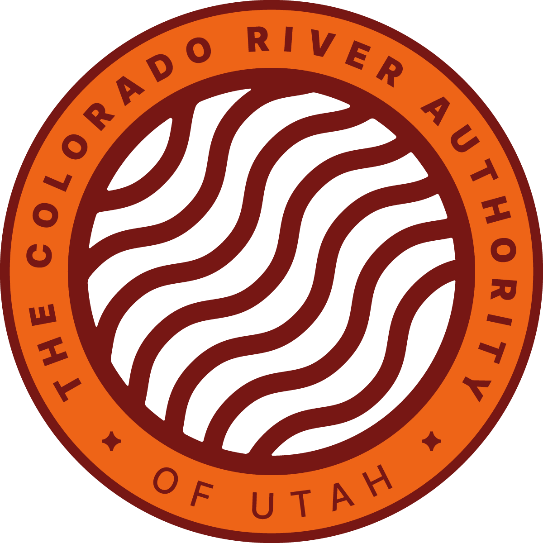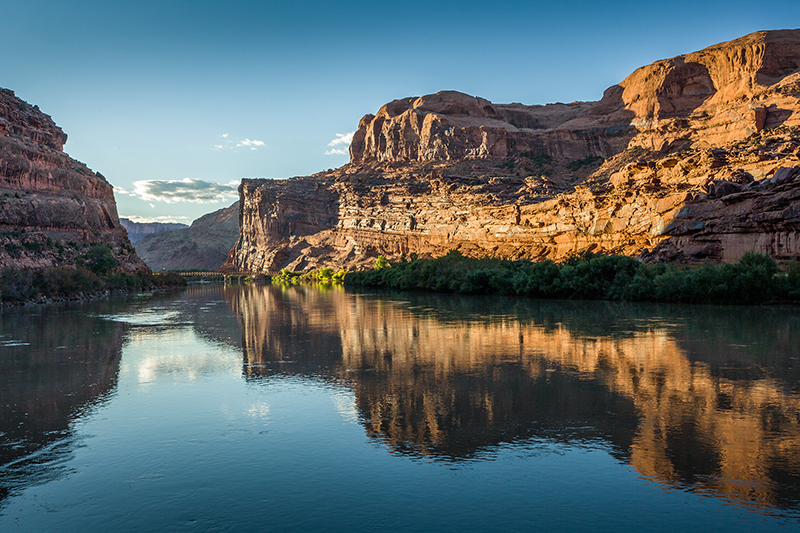
Colorado River Authority of Utah
During the 2021 legislative session, the Legislature created the Colorado River Authority of Utah, a state agency in the Governor’s Office whose mission is to protect, preserve, conserve and develop Utah’s Colorado River interests. While the authority and its River Commissioner are focused on relationships with the six other Colorado River Compact states, the Division of Water Resources works closely with the authority on behalf of Utah citizens.

The Colorado River provides water to more than 40 million people in seven states and Mexico. The Colorado River is highly esteemed for both its iconic beauty and as a vital natural resource. It is often described as the most regulated river in the world with a complex and extensive history surrounding its development.
Utah’s Allocation
Approximately 27% of the water used in Utah comes from the Colorado River and 60% of Utahans benefit directly from the river. The collection of compacts, agreements, federal laws and court decisions that define how the river is managed is commonly referred to as “The Law of the River.” Each of the Upper Basin states (Colorado, New Mexico, Utah and Wyoming) and the Lower Basin states (Arizona, California and Nevada) is appropriated the right to beneficially use a portion of the river’s water. Each Basin state must supply tribal water rights within the state from its appropriation.
Utah’s compact allocation is 23% of the available water supply appropriated to the Upper Basin. Utah is committed to living within its allocation. We acknowledge the hydrology has changed and are carefully analyzing how drought and a changing climate may impact Utah and its water projects into the future.
Like other states with available Colorado River water, Utah may develop its remaining appropriation. Utah’s population is projected to double by 2065, placing an increased demand on water supplies, and the Colorado River is a critical water source for Utah.
Planning for the use of Utah’s allocation includes the Lake Powell Pipeline (LPP), which will deliver water to Utah’s fast-growing Washington County. Utah recognizes that it must develop and operate the pipeline in accordance with the Law of the River and the available supply. Utah is thoroughly evaluating hydrology to determine how the pipeline fits within Utah’s Colorado River allocation and current uses.
Utah’s use of its Colorado River water comports with the Law of the River and does not compromise the legal appropriations of other states. The Basin states have a long history of working together to address complex issues. That trend must continue for the benefit of the river and all who depend on it.
Chronology of Policy
Balancing river resources between states and other interests is an ever-evolving process, and this chronology of policy has expanded since the inception of the 1922 Colorado River Compact.
Colorado River Compact 1922: Negotiated by the seven basin states and the federal government, it defines the relationship between the Upper Basin states (Colorado, New Mexico, Utah and Wyoming) and the Lower Basin states (Arizona, California and Nevada) and protects each state’s right to develop its allocation on its own timeframe. Each basin was allocated the right to beneficially use 7.5 million acre-feet of river water annually.
Upper Colorado River Basin Compact 1948: Created the Upper Colorado River Commission and apportioned the Upper Basin’s available water supply proportionally among the Upper Basin states: Colorado (51.75%), New Mexico (11.25%), Utah (23%) and Wyoming (14%). The portion of Arizona that lies within the Upper Colorado River Basin was also apportioned the right to use 50,000 acre-feet annually.
Interim Guidelines (2007): The 2007 interim operational guidelines address the coordinated operations of Lake Powell and Lake Mead during low reservoir conditions, and remain in effect through 2025.
Drought Contingency Plan (2019): The Upper and Lower Colorado River Basin states have drought developed contingency plans both independently and collaboratively. The product of these discussions is five documents that comprise the Drought Contingency Plan (DCP) for the Colorado River. They are:
- Companion Agreement
- Upper Basin Drought Response Operations Agreement
- Upper Basin Demand Management Storage Agreement
- Lower Basin Drought Contingency Plan Agreement
- Lower Basin Drought Contingency Operations
Additional Resources
- Colorado River Water Users Association
- River Story – A visual snapshot of the Colorado River and its importance to Utah and its citizens.
- Timeline – A timeline of Colorado River Compact and key events.
- Water Use Reporting – Utah has a comprehensive approach to measuring water use and includes all treated and untreated water. Find out what all goes into the state’s gallons per capita per day metric and how it’s used for planning purposes.
- Bureau of Reclamation Colorado River Basin
- Lake Powell Pipeline – a comprehensive project website.
